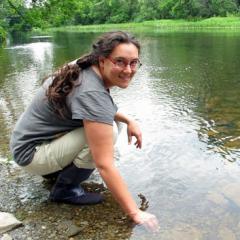Thelen's work with amphibian crossing featured in Washington Post
Wood frogs lie frozen in suspended animation. Salamanders wait below the frost line for the signal to return where they were born. A trifecta of thawing ground, favorable temperature and rain cues them to emerge and migrate to vernal pools for nights of communal courtship and explosive breeding.
When they do, Keene, N.H., is committed to making sure they don’t land under the wheels of passing cars.
For the second year, Keene’s City Council unanimously voted to set up road closures and barriers on nights of major amphibian migration. It’s a two-way gift: nature returns the favor, leaving lasting impressions on those who thrill to see hundreds of frogs hopping out of the woods.
“This is the only time of the year when they come above ground and move, which is what makes it feel really kind of magical,” says Brett Amy Thelen, science director of Harris Center for Conservation Education in Hancock, N.H.
Thelen obsessively monitors weather and keeps a Five-Day Salamander Forecast on the center’s website. This year’s first big amphibian migration probably took place in the wee hours of April 8 while folks were slumbering. Fortunately, migrations happen over multiple nights, and on April 12, after some nail-biters, conditions finally looked promising for action during human waking hours.
The Keene Public Works Department got the green light from Thelen, put the word out on social media, and set road barriers and signage in place: North Lincoln Street would be closed to help an amphibian migration.
